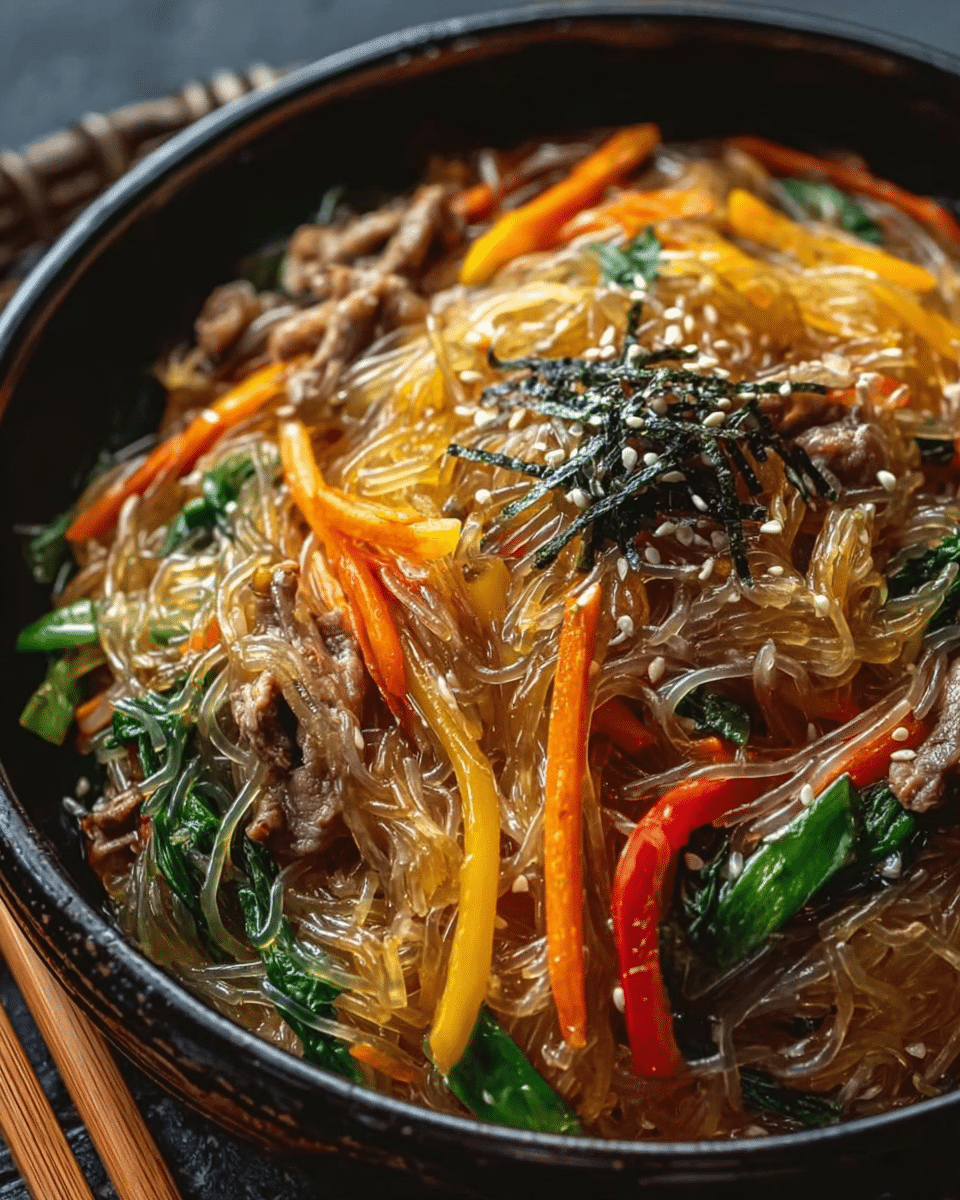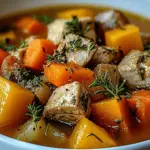Japchae is one of Korea’s most beloved noodle dishes — a beautiful stir-fry of chewy sweet potato noodles, marinated beef, and colorful vegetables. Infused with a savory sesame-soy sauce and garlic, this dish is as balanced in flavor as it is visually stunning. A staple during Korean holidays and celebrations, Japchae is meant to be shared and enjoyed with loved ones. The magic of Japchae lies in its versatility. Whether you’re preparing it with tender beef, tofu, or skipping the protein altogether, the dish holds its flavor and integrity. Served warm or at room temperature, it makes an excellent main or side dish. Its vibrant colors and textures make Japchae not only delicious but also a showpiece at the dinner table.
Full recipe:
Ingredients:
-
2 lb thin-sliced beef (or substitute with chicken, tofu, or shrimp)
-
1 lb Korean sweet potato noodles (glass noodles)
-
3 medium carrots, julienned
-
1 large white onion, thinly sliced
-
½ bunch green onions, chopped
-
6 garlic cloves, minced
-
½ lb spinach leaves
-
4 tbsp sesame oil, divided
-
1 tbsp olive oil
-
6 tbsp soy sauce (or tamari for gluten-free option)
-
3 tbsp brown sugar
Directions:
-
Bring water to a boil in a large pot. Add a drizzle of olive oil, then the sweet potato noodles. Cook for 5–6 minutes. Drain and set aside.
-
In a skillet over high heat, cook the beef until browned. Season with half the soy sauce, sesame oil, and brown sugar while cooking. Remove from pan and set aside.
-
In another skillet, heat olive oil and cook the carrots and onion until softened.
-
Add the remaining soy sauce, sesame oil, and brown sugar. Stir in garlic and green onions; cook for 1 more minute.
-
Add spinach and cook just until wilted.
-
Combine the cooked noodles, beef, and sautéed vegetables in a large mixing bowl. Toss thoroughly to combine.
-
Serve warm, garnished with extra green onions if desired.
Prep Time: 30 minutes | Cooking Time: 30 minutes | Total Time: 1 hour
Kcal: 489 per serving | Servings: 10 servings
A Korean Classic: What is Japchae?
Japchae (잡채), one of Korea’s most beloved dishes, is a stir-fried noodle dish made primarily with sweet potato starch noodles (dangmyeon), assorted vegetables, and often thinly sliced beef. Translated loosely as “mixed vegetables,” Japchae is a perfect balance of savory and sweet, enhanced with the aromatic notes of sesame oil and soy sauce.
Unlike many noodle dishes around the world, Japchae has a unique appeal due to its translucent glass noodles, tender-crisp vegetables, and its adaptability. It can be served warm or at room temperature and is often seen at festive occasions, family gatherings, and as part of celebratory meals.
Historical and Cultural Significance
Japchae originated in the early 17th century during the Joseon Dynasty. It was first prepared as a royal dish for King Gwanghaegun. Originally, it didn’t include noodles but rather a mix of seasonal vegetables. Over time, the dish evolved with the introduction of dangmyeon (sweet potato starch noodles), which became central to the dish’s modern form.
Today, Japchae is deeply embedded in Korean food culture. It is commonly served during Korean holidays such as Seollal (Lunar New Year) and Chuseok (Korean harvest festival). Its multicolored ingredients symbolize balance, prosperity, and harmony—core values in traditional Korean philosophy.
Because of its festive look and universally appealing taste, Japchae often acts as a gateway dish for those new to Korean cuisine.
Ingredient Spotlight: The Unique Elements of Japchae
At first glance, Japchae may look like a typical noodle stir-fry. But its ingredients make it one of the most texturally and nutritionally balanced dishes in Korean cuisine.
Sweet Potato Glass Noodles (Dangmyeon)
These translucent noodles are made from 100% sweet potato starch and water, making them naturally gluten-free. They have a chewy, bouncy texture unlike any wheat-based noodle and absorb the flavors of the sauce beautifully.
Assorted Vegetables
Japchae commonly features julienned carrots, onions, spinach, mushrooms, and green onions. Each vegetable is cooked separately to preserve its color and texture. This method showcases the care and intention behind the dish.
Protein Options
Traditional Japchae includes thinly sliced beef, but chicken, shrimp, tofu, or even mushrooms can be used for dietary flexibility. It’s easily adaptable for vegetarians and vegans.
Soy Sauce and Sesame Oil
These pantry staples are the backbone of Japchae’s signature flavor. The combination creates a savory, nutty, and slightly sweet profile that enhances every component.
Garlic and Brown Sugar
Garlic adds depth, while brown sugar balances out the saltiness and brings warmth to the dish without making it overly sweet.
Health Benefits and Nutritional Profile
Despite its rich and satisfying flavor, Japchae is surprisingly health-conscious. It delivers a wide range of macronutrients and essential vitamins, making it a great option for a balanced meal.
-
Gluten-Free and Low in Fat: The use of sweet potato noodles makes it naturally gluten-free and low in unhealthy fats.
-
High in Fiber and Antioxidants: The mix of vegetables adds plenty of fiber, which supports digestion and keeps you feeling full longer. Spinach, onions, and carrots offer antioxidants that help fight inflammation.
-
Lean Protein Source: Whether you use beef, tofu, or chicken, Japchae includes a solid source of protein for muscle repair and energy.
-
Heart-Healthy Fats: Sesame oil, a staple in this dish, contains polyunsaturated fats and antioxidants that can help reduce cholesterol and support heart health.
-
Low Glycemic Index: Sweet potato noodles digest more slowly than refined carbs, preventing blood sugar spikes and crashes.
For those tracking calories, Japchae comes in at around 489 kcal per serving, making it a relatively light yet satisfying option.
Why Japchae is Perfect for Every Occasion
There are many reasons why Japchae holds such a special place in Korean homes—and why it’s gaining popularity globally.
1. Visual Appeal
With its rainbow of ingredients, Japchae is one of the most beautiful dishes to serve at the table. The vibrant greens, oranges, and golden browns create a festive and mouthwatering presentation.
2. Customizable and Inclusive
You can easily tailor Japchae to suit nearly any dietary preference. Want to make it vegan? Swap the beef for tofu or mushrooms. Avoiding gluten? Use tamari instead of soy sauce. Looking to reduce carbs? Just increase the veggie-to-noodle ratio.
3. Meal Prep Friendly
Japchae tastes just as good—if not better—after it sits. It’s an ideal dish for meal prep since it holds up well in the fridge and can be served cold or reheated with minimal effort.
4. Comforting but Light
Unlike cream-based pasta dishes or heavy stir-fries, Japchae offers a clean, light feel while still delivering full flavor. It’s a comfort food that doesn’t leave you feeling weighed down.
5. Easy to Scale Up
Whether you’re feeding two or twenty, Japchae scales beautifully. It’s a go-to dish for parties, potlucks, and gatherings of all sizes.
Cooking Japchae at Home: Step-by-Step Tips
Preparing Japchae is relatively simple once you understand the method. The key is to cook each component separately before combining, to preserve the integrity of each ingredient.
Cook the Noodles Properly
Boil sweet potato noodles until tender but not mushy (about 5–6 minutes). After draining, rinse with cold water and toss with a bit of sesame oil to prevent sticking.
Sauté in Stages
Avoid tossing all the vegetables into the pan at once. Sauté carrots and onions first until soft. Add spinach and green onions at the end since they require minimal cooking.
Balance the Sauce
Start with soy sauce, sesame oil, and brown sugar in equal balance. Taste and adjust gradually—some may prefer a saltier, sweeter, or more sesame-forward profile.
Don’t Skip the Garlic
Fresh garlic adds irreplaceable depth. Stir it in toward the end to prevent burning but still allow it to bloom in the oil.
Toss Well Before Serving
Once everything is cooked, combine all elements in a large bowl. Toss thoroughly so the sauce coats the noodles and veggies evenly.
Serving Suggestions and Pairings
Japchae is incredibly versatile in terms of how you serve it.
-
As a Main Dish: Add protein like beef or tofu, and serve warm with a side of kimchi or pickled radish.
-
As a Side Dish (Banchan): Serve in smaller portions alongside Korean BBQ, bibimbap, or grilled meats.
-
In Bento Boxes or Lunches: Japchae holds up well and can be enjoyed at room temperature, making it ideal for packed lunches.
-
With a Soup or Stew: Pair it with miso soup or a Korean seaweed soup for a well-rounded meal.
Add-ons like toasted sesame seeds or a drizzle of gochujang (Korean chili paste) give Japchae an extra flavor boost if desired.
Common Variations to Explore
If you’ve made traditional Japchae and want to experiment further, consider trying these popular spins on the classic:
-
Spicy Japchae: Add gochujang or crushed red pepper flakes.
-
Seafood Japchae: Swap the beef for shrimp or scallops.
-
Vegetarian Japchae: Use shiitake mushrooms and double the vegetables for a hearty, meatless meal.
-
Mini Japchae Pancakes: Mix leftover Japchae with egg and pan-fry into savory noodle pancakes.
These variations keep the dish exciting while maintaining its comforting base.
Why Japchae Deserves a Spot in Your Recipe Rotation
Japchae isn’t just a dish—it’s an experience. The balance of flavors and textures, the vibrant presentation, and the cultural significance all contribute to its special place in global cuisine. Whether you’re new to Korean food or already a fan, Japchae invites you to slow down, savor, and share.
The fact that it’s easy to make, healthful, and endlessly customizable means it fits a wide variety of dietary needs and preferences. It’s a dish that can be adapted for every season, occasion, and taste, making it a staple worth mastering.
Conclusion
Japchae is a shining example of how tradition, nutrition, and flavor can come together in one harmonious dish. With its chewy sweet potato noodles, colorful vegetables, and deeply savory sesame-soy flavor, it offers comfort and sophistication in equal measure. Whether served as a celebratory centerpiece or a cozy weekday meal, Japchae never fails to impress. Add it to your kitchen repertoire, and you’ll find yourself turning to it time and time again—for guests, for family, and for yourself.






